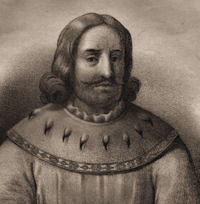Lent: March 2nd
Thursday of the First Week of Lent
Other Commemorations: Bl. Charles the Good, Martyr (RM)
» Enjoy our Liturgical Seasons series of e-books!
In certain ways the Lenten Christian is like the Jew in exile. He is still exposed to the attacks of the enemies. Lent, like the exile in Babylon, is a time of cleansing. It intends to create in us a greater desire and longing for deliverance which God has promised us through our savior Jesus Christ. All the chants and prayers in today's Mass are urgent pleas for God's mercy and help.
The Church has fittingly assumed the prayer of Esther as her own today. Like the Jews of old, she finds her people in many countries fighting against a well-organized plan of a persecution and extermination, more terrible than the one the Jews had to face. She is undergoing this trial to show her fidelity to Christ, and to plead for the salvation of all men. —St. Andrew Bible Missal
Today is the feast of Blessed Charles the Good (1083-1127), the Danish prince, son of the holy King Canuto IV, gained the crown of the Count of Flanders from his maternal lineage. After an initial brief interval, his reign was marked by peace and justice. Dedicated to the defense and aid of the poor and weak, he was killed by soldiers that he had tried to pacify. Leo III officially beatified him in 1882 and the new Roman Martyrology commemorates the anniversary of his martyrdom.
Meditation—Confidence and Union with God in Temptation
Nothing is more efficacious against temptation than the remembrance of the Cross of Jesus. What did Christ come to do here below if not to "destroy the works of the devil"? And how has He destroyed them, how has He "cast out" the devil, as He Himself says, if not by His death upon the Cross?
Let us then lean by faith upon the cross of Christ Jesus, as our baptism gives us the right to do. The virtue of the cross is not exhausted. In baptism we were marked with the seal of the cross, we became members of Christ, enlightened by His light, and partakers of His life and of the salvation He brings to us. Hence, united to Him, whom shall we fear? Dominus illuminatio mea et salus mea; quern timebo? Let us say to ourselves: "He hath given His angels charge over thee to keep thee in all thy ways."
"Because he hoped in Me (says the Lord) I will deliver him; I am with him in tribulation, I will deliver him, and I will glorify him. I will fill him with length of days, and I will show him My salvation."
—Excerpted from Christ the Life of the Soul, Dom Marmion
Blessed Charles the Good
Count Charles of Flanders, was called "the good" by the people of his kingdom. They named him for what they found him to truly be. He was the son of St. Canute, king of Denmark. Charles was just five years old when his father was murdered in 1086. When Charles grew up, he married a good young woman named Margaret. Charles was a mild and fair ruler. The people trusted him and his laws. He tried to be an example of what he expected the people to be.
Some nobles accused Charles of unjustly favoring the poor over the rich. He answered kindly, "It is because I am so aware of the needs of the poor and the pride of the rich." The poor of his realm were fed daily at his castles.
Charles ordered the abundant planting of crops so that the people would have plenty to eat at reasonable prices. Some wealthy men tried to hoard grain to sell at very high prices. Charles the Good found out and forced them to sell immediately and at fair prices. An influential father and his sons had been reprimanded by Charles for their violent tactics. They joined the little group of enemies who now wanted to kill him.
The count walked every morning barefoot to Mass and arrived early at the Church of St. Donatian. He did this in a spirit of penance. He longed to deepen his own spiritual life with God. His enemies knew that he walked to church and also that he prayed often alone before Mass. Many people who loved Charles feared for his life. They warned him that his walks to St. Donatian could lead to his death. He replied, "We are always in the middle of dangers, but we belong to God." One morning, as he prayed alone before the statue of Mary, his attackers killed him. Charles was martyred in 1127.
>—Excerpted from Holy Spirit Interactive
Patronage: counts; Crusaders; diocese of Burges, Belgium
Symbols and Representation: nobleman with a purse and a sword; depicted after his martyrdom in the cathedral; sword
Highlights and Things to Do:
- Read more about Bl. Charles:
- His remains are in the Sint-Salvatorskathedraal or Saint-Salvator Cathedral of Bruges, Flanders, in present-day Belgium.
 Saturday of the Second Week of Lent
Saturday of the Second Week of Lent
Station with Santi Marcellino e Pietro al Laterano (Saints Marcellinus and Peter):
The Station is in the church of Sts. Peter and Marcellinus, two celebrated martyrs of Rome under the persecution of Diocletian. Their relics were brought to the church in 1256, and the church was restored the same year on order from Pope Alexander IV. Santi Marcellino e Pietro al Laterano is a Roman catholic parish on the Via Merulana at the intersection with via Labicana. Their feast day is June 2..
For more on Santi Marcellino e Pietro al Laterano, see:
For further information on the Station Churches, see The Stational Church.







